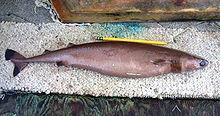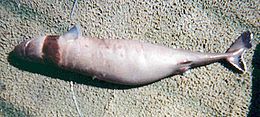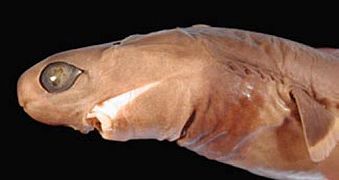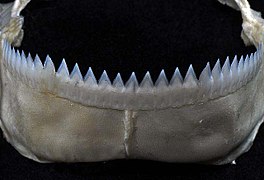Cookiecutter shark
| Cookiecutter shark | |
|---|---|

| |
| Scientific classification | |
| Domain: | Eukaryota |
| Kingdom: | Animalia |
| Phylum: | Chordata |
| Class: | Chondrichthyes |
| Subclass: | Elasmobranchii |
| Subdivision: | Selachimorpha |
| Order: | Squaliformes |
| Family: | Dalatiidae |
| Genus: | Isistius |
| Species: | I. brasiliensis
|
| Binomial name | |
| Isistius brasiliensis | |

| |
| Range of the cookiecutter shark | |
| Synonyms | |
|
Isistius labialis Meng, Chu & Li, 1985 | |
The cookiecutter shark (Isistius brasiliensis), also called the cigar shark, is a
The name "cookiecutter shark" refers to its feeding method of gouging round plugs, as if cut out with a
Though rarely encountered because of its oceanic
Taxonomy
French
One of the earliest accounts of the wounds left by the cookiecutter shark on various animals is in ancient Samoan legend, which held that atu (
Description
The cookiecutter shark has an elongated, cigar-shaped body with a short, bulbously rounded snout. The nostrils have a very short flap of skin in front. The large, oval, green eyes are placed forward on the head, though not so that binocular vision is extensive. Behind the eyes are large spiracles, positioned on the upper surface of the head.
The mouth is short, forming a nearly transverse line, and is surrounded by enlarged, fleshy, suctorial lips. The upper jaw has 30–37 rows of teeth, and the lower jaw has 25–31, increasing with body size. The upper and lower teeth are extremely different; the upper teeth are small, narrow, and upright, tapering to a single, smooth-edged cusp. The lower teeth are also smooth-edged, but much larger, broader, and knife-like, with their bases interlocking to form a single saw-like cutting edge. The five pairs of gill slits are small.[3][5][6]
The
The fins have translucent margins, except for the caudal fin, which has a darker margin.[5] Complex, light-producing organs called photophores densely cover the entire underside, except for the collar, and produce a vivid green glow.[5] The maximum recorded length for this species is 42 cm (17 in) for males and 56 cm (22 in) for females.[9]
-
The cookiecutter shark has a short, rounded head with large, anteriorly placed eyes and a transverse mouth.
-
Head
-
Jaws
-
Lower teeth
-
Upper teeth
-
Jaw diagram
Distribution and habitat
Inhabiting all of the world's major tropical and warm-
Based on catch records, the cookiecutter shark appears to conduct a
Biology and ecology

Best known for biting neat round chunks of
The cookiecutter shark regularly replaces its teeth like other sharks, but sheds its lower teeth in entire rows rather than one at a time. A cookiecutter shark has been calculated to have shed 15 sets of lower teeth, totaling 435–465 teeth, from when it was 14 cm (5.5 in) long to when it reached 50 cm (20 in),[11] a significant investment of resources. The shark swallows its old sets of teeth, enabling it to recycle the calcium content.[6]
Unlike other sharks, the retina of the cookiecutter shark has ganglion cells concentrated in a concentric area rather than in a horizontal streak across the visual field; this may help to focus on prey in front of the shark.[15]
This shark has been known to travel in schools, which may increase the effectiveness of its lure (see below), and discourage attacks by much larger predators.[12]
Bioluminescence

The intrinsic green luminescence of the cookiecutter shark is the strongest known of any shark, and has been reported to persist for three hours after it has been taken out of water.
Set apart from the glowing underside, the darker, nonluminescent collar tapers at both sides of the throat, and has been hypothesized to serve as a lure by mimicking the silhouette of a small fish from below. The appeal of the lure would be multiplied in a school of sharks. If the collar does function in this way, the cookiecutter shark would be the only known case of bioluminescence in which the absence of light attracts prey, while its photophores serve to inhibit detection by predators.[12][13] As the shark can only match a limited range of light intensities, it has been suggested that its vertical movements might serve to preserve the effectiveness of its disguise across various times of day and weather conditions.[12]
Feeding

Virtually every type of medium- to large-sized oceanic animal sharing the habitat of the cookiecutter shark is open to attack; bite scars have been found on
Parasitic attacks by the cookiecutter shark leave a round "crater wound", averaging 5 cm (2.0 in) across and 7 cm (2.8 in) deep.
The cookiecutter shark exhibits a number of specializations to its mouth and
Life history
Like other dogfish sharks, the cookiecutter shark is
Human interactions

Favoring offshore waters and thus seldom encountered by humans, the cookiecutter shark is not considered dangerous because of its small size. However, it has been implicated in a few
There are several records of human bodies recovered from the water with post-mortem cookiecutter shark bites.[14][32][33]
During the 1970s, several
The harm inflicted by cookiecutter sharks on
References
- ^ . Retrieved November 12, 2021.
- ^ Quoy, J.R.C.; J.P. Gaimard (1824–1825). "des Poissons. Chapter IX". In de Freycinet, L (ed.). Voyage autour du Monde...exécuté sur les corvettes de L. M. "L'Uranie" et "La Physicienne," pendant les années 1817, 1818, 1819 et 1820. Paris. pp. 192–401.
- ^ ISBN 978-0-520-23484-0.
- ^ Gill, T.N. (1865). "Synopsis of the eastern American sharks". Proceedings of the Academy of Natural Sciences of Philadelphia. 16 (5): 258–265.
- ^ a b c d e f Bester, C. Biological Profiles: Cookiecutter Shark Archived April 9, 2013, at the Wayback Machine. Florida Museum of Natural History Ichthyology Department. Retrieved on January 26, 2010.
- ^ ISBN 978-92-5-101384-7.
- ^ Jones, E.C. (1971). "Isistius brasiliensis, a Squaloid Shark, the Probable Cause of Crater Wounds on Fishes and Cetaceans" (PDF). Fisheries Bulletin. 69 (4): 791–798.
- ^ ISBN 978-0-8117-2875-1.
- ^ a b Froese, Rainer; Pauly, Daniel (eds.) (2009). "Isistius brasiliensis" in FishBase. November 2009 version.
- S2CID 86259333.
- ^ JSTOR 1441272.
- ^ S2CID 45347124.
- ^ a b Milius, S. (August 1, 1998). Glow-in-the-dark shark has killer smudge. Science News. Retrieved on December 15, 2014.
- ^ a b c d e f g Martin, R.A. Deep Sea: Cookiecutter Shark. ReefQuest Centre for Shark Research. Retrieved on January 26, 2010.
- S2CID 26648368.
- ISBN 978-0-12-350403-6.
- ISBN 978-0345547118.
- ^ a b c Martin, R.A. Squaliformes: Dogfish Sharks. ReefQuest Centre for Shark Research. Retrieved on January 26, 2010.
- S2CID 86420663.
- ^ a b Martin, R.A. Attacked by a Dogfish. ReefQuest Centre for Shark Research. Retrieved on January 26, 2010.
- ^ ISBN 978-0-8493-1514-5.
- .
- ^ .
- ^ Perry, B. (March 21, 2009). "Cookie-cutter sharks 'sort of a mosquito of the sea'" Archived March 3, 2016, at the Wayback Machine. The Maui News. Retrieved on January 26, 2010.
- S2CID 85627382.
- ^ "Rare Cookiecutter Shark Bite in Hawaii". March 18, 2019.
- ^ "Second cookiecutter shark bite reported in Hawaii". April 17, 2019.
- ^ "In rare third incident for year, swimmer attacked by cookiecutter shark". November 20, 2019.
- ^ McMurray, Kevin (November 1, 2017). "7-year-old bitten by cookiecutter shark in Australia". Tracking Sharks. Retrieved January 18, 2023.
- ^ McMurray, Kevin (December 15, 2022). "Man fights off shark attack with diving knife". Tracking Sharks. Retrieved January 18, 2023.
- ^ McMurray, Kevin (April 24, 2023). "Hawaiian swimmer fast-pitches attacking cookiecutter sharks". Tracking Sharks. Retrieved April 29, 2023.
- PMID 15166773.
- PMID 27623973.
- ^ Johnson, C.S. (1978). "Sea Creatures and the Problem of Equipment Damage". U.S. Naval Institute Proceedings. August 1978: 106–107.
- ^ ISBN 978-1-60239-021-8.
- OCLC 1042901090.







